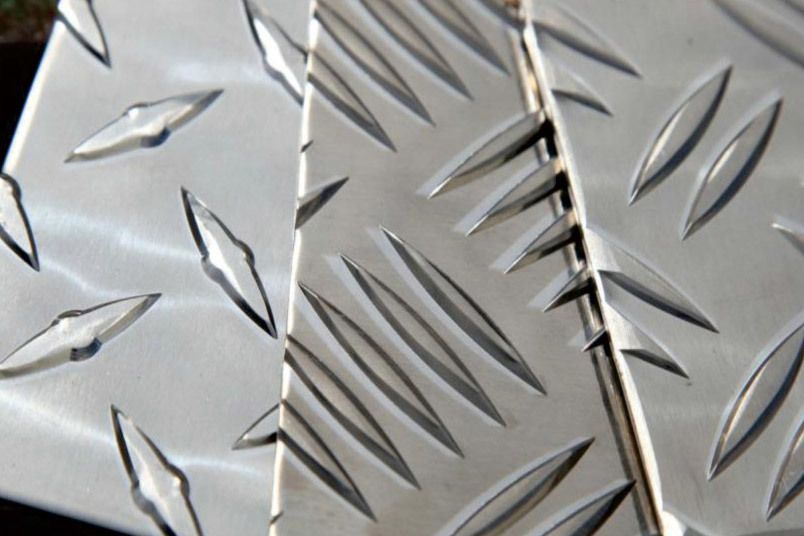Rust Resistant Aluminum Tread Plate
Oct-30-2025
Rust resistant aluminum tread plate is an aluminum alloy plate with a special surface pattern, primarily used to improve slip resistance and aesthetics while providing excellent rust resistance. Rust resistant aluminum tread plate is widely used in construction, transportation, shipbuilding and home appliances.

Types of rust resistant aluminum tread plate
1. By alloy system
3000 series aluminum-manganese alloy (e.g., 3003):
Contains manganese (approximately 1%), with slightly higher strength than pure aluminum, good corrosion resistance, and lower cost. Suitable for applications with moderate rust resistance requirements (e.g., truck beds, cold storage floors).
- 5000 series aluminum-magnesium alloy (e.g., 5052, 5083, 5754):
Higher magnesium content (3-5%), significantly better strength and corrosion resistance than the 3000 series aluminum tread plate, especially resistant to seawater and chemical corrosion. Commonly used in ship decks, equipment in humid environments, and structures requiring high load-bearing capacity.
2. By pattern type
- Five bars (Willow Leaf Pattern):
Five raised and recessed lines at 60-80 degree angles on the surface, providing excellent slip resistance. A mainstream choice for building floors and platforms.
- Lentil-shaped:
Strong three-dimensional texture, balanced between anti-slip and load-bearing capacity, commonly used for vehicle, elevator, and workshop floors.
- Orange peel texture:
Surface mimics orange peel texture, aesthetically pleasing and wear-resistant, often used for appliance casings and packaging containers.
- Diamond texture:
Compact structure, suitable for pipe wrapping or outer packaging protection.
Advantages of rust resistant aluminum tread plate:
- Rust resistance:
The naturally formed oxide film (Al₂O₃) on the aluminum alloy surface resists conventional corrosion. 3000 series and 5000 series aluminum alloys further enhance corrosion resistance through alloying elements. Special surface treatments (such as anodizing and fluorocarbon coating) can extend service life to 10-20 years, suitable for coastal or chemical environments.
- Lightweight and high strength:
The tensile strength of 3003-H24 is approximately 160MPa, and 5052-H32 can reach 230MPa, far exceeding that of ordinary carbon steel (approximately 235MPa), while its density is only 1/3 that of steel, achieving a balance between lightweight and high strength. Patterned designs, achieved through cold pressing, increase sheet rigidity without increasing thickness. For example, lentil-patterned aluminum sheets have 15-20% higher bending strength than flat sheets.
- Patterned Design:
The surface pattern not only enhances aesthetics but also improves slip resistance, making it suitable for surfaces and ramps requiring anti-slip properties.
- Good Processability:
Rust-resistant aluminum tread plate are easy to cut, weld, and form, allowing for customized processing.
- Weather Resistance:
Aluminum alloys exhibit excellent stability under various climatic conditions, making them suitable for outdoor applications.
Application scenarios of rust resistant aluminum tread plate:
- Construction:
Anti-slip flooring, stair treads, curtain wall decoration (e.g., high-speed rail stations, airports), with five-ribbed patterned sheets widely used due to their high anti-slip coefficient (static friction coefficient ≥0.6).
Roofing and wall materials; combined with fluorocarbon coating, weather resistance can be achieved for over 30 years.
- Transportation:
Floors and interior walls of rail transit vehicles (5052 aluminum material reduces vehicle weight and improves fire resistance). For ship decks and cargo hold linings, 5083 aluminum alloy exhibits a corrosion rate in seawater that is only 1/10 that of ordinary steel.
- Industrial equipment:
Linings for chemical storage tanks and reaction vessel platforms (3003 or 5052, after passivation treatment, demonstrates excellent acid and alkali resistance).
For food processing workshop floors, orange peel textured panels facilitate cleaning and meet hygiene standards.